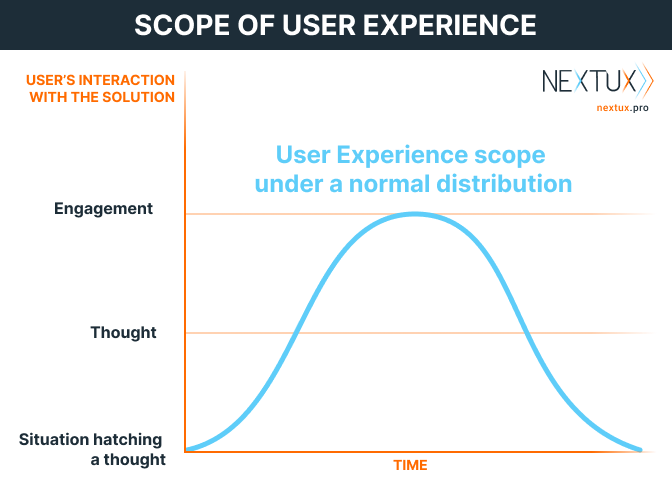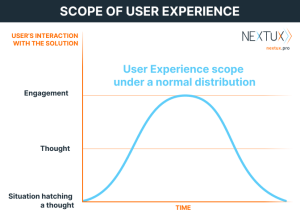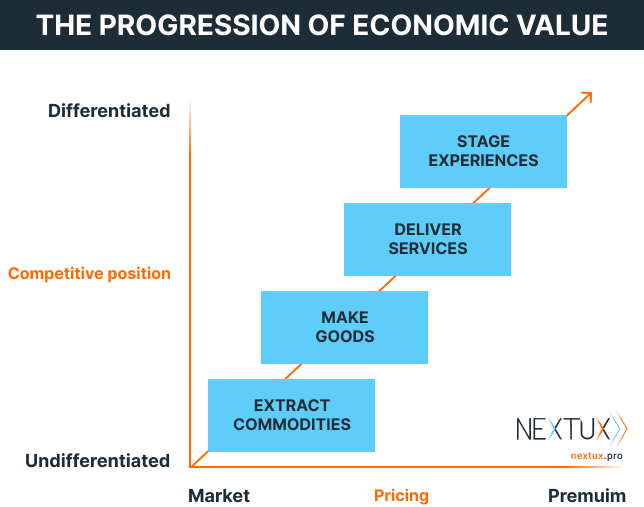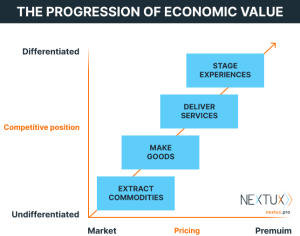Summary
User experience embodies all elements a user seeks from an organization’s offering, remaining uninterrupted from the intention to use the solution to the lingering impression after its active use, categorized into products, services, and experiential tiers.
User experience’s scope is everything a user needs and wants from an organization’s offering. The best user experience happens without any disturbance in the delivery of such offering.
To contextualize these definitions we’ll stay as close as possible to the economic aspect of supply and demand. The “user” is the human user (in the days of the awaking of AI, it’s more important than ever to specify this) consuming or interacting with a solution, and “experience” is meant to be observed from the moment there’s an intention to use such solution (modern companies are studying the intention even if the transaction is abandoned), to the moment when the experience is still present within the user (sensation or “aftertaste”) after concluding the active use of the solution.


The key is to consider that the mere thought about a product, a service or any offer, is already an engagement with such offer, and the thought after consuming such an offer, is still an active engagement. Maybe this engagement is not as tangible as the action at the point of transaction, but it’s an engagement at last. Think about it, before visiting a restaurant, you have a very clear idea of what you want, an expectation is set; and the restaurant owner, would do anything to meet that expectation. The graphic below proposes that we reduce the uncertainty of delivering a top-notch experience and take a step further, imagining (before you get reliable data), what could have created that thought to engage with the offer in the first place (what was the “situation that hatched that thought”). By thinking like this, the scope of user experience is defined through a wider range of empathy with the end user; inevitably we must start thinking about their needs, their circumstances, environment, behavior, and overall ecosystem in which these ideas come to mind. It all comes together when the designers of the solution track back the steps the consumer took to get to the point of transaction. By creating a customer journey map, and tracking back to the “thought-hatching” step of the engagement, the gaps and wins of the user experience quickly surface, showing the opportunities to fine-tune and elevate your offer and differentiate it from competitors.
User Experience and Experience Economy
Following the progression of economic value, we can define user experience for three main tiers, products, service and experience (this last one, as a differentiated product).


Product
The experience of a product can be measured primarily by the physicality of the artifact. Shape, color, texture, smell, weight, volume, and other immediate physical properties. The unboxing is a whole category of experiences, for many as important as the product itself.
Examples:
- The way a dish is plated
- Presentation of a cappuccino
- Unboxing an Apple product
- Scent of a brand new car
Service
One step above the product in the progression of the economic value, the service’s experience is starting to get closer to a full experiential delivery. The provider of the service must look into the touchpoints of the service delivery, as every detail matters to successfully meet user’s needs and wants.
Examples:
- Customer service to support a product
- Multiple services that are necessary to deliver a product, like in tourism, with transportation, lodging, entertainment, etc.
Experience
At this moment, experience-as-a-product is at the cuspid of the economic value. The common user is very sophisticated, and products and services are not only commoditized in terms of price, they are also commoditized from the perspective of what the consumer want and need. Products and services must be delivered through staged experiences to compete in current markets. The definition of user experience extrapolates into the realm of virtually everything that has to do with the end user, every single second matters. Products and services are baked into this staged experience, with their value elevated to the standard of the theme of your staged experience. Money is no longer the payment method, it has also been commoditized, time is the currency.
Examples:
- Disney
- Meow Wolf
- Rainforest Cafe
To deliver high-value experiences in today’s market, it is a must to understand the sophisticated needs and wants of the modern users. Experience is to be defined in contexts beyond of the traditional unidimensional solution (a service, a website, a user interface, etc.), everything matters and the user expects much more than before, by far, and is willing to drop a product or a service if the experience that goes along is not intentionally polished, delightful and personalized to an elevated degree. Correspondently, the end user gets annoyed, bored, and irritated to a point of no-return, if the right experiencial conditions are not met. From many angles, the consumer has surrendered privacy in exchange to personalization, which is the key attribute of the economic distinction in the experience economy.
Based on these three tiers of the progression of economic value, we can start thinking about intentionally designing the experience for each tier. The question is, what type of experience are you fixing? Do you sell a product, provide a service or sell experiences?
“User Experience (UX) is a multidisciplinary and holistic approach that focuses on providing the right solution, optimizing delightfulness and minimizing noise.”
Emil Aliev
No matter what experience you are designing or fixing, the intentionality behind every step, matters. If you don’t think about it, your end user will. In every scenario and step of the customer journey, optimizing delightfulness and minimizing noise, is key. If you don’t do it, your competitor will.
User interface vs. User experience
The interface between the solution and the user is an essential part, and designing it thoughtfully becomes a fundamental task of the User Experience profession. Having said this, UX can’t be reduced to the design of the user interface only, user experience goes beyond. Similarly, “user interface” shouldn’t be reduced to graphic interfaces only (think about voice-activated software). The user interface could be considered as one of the touchpoints of the experience, and of course, for some solutions it might represent a good portion of the customer journey in terms of touch points but it’s not the only artifact (as mentioned before, there are more properties). You can clearly see this with digital solutions, especially apps. But a trained UX professional should think about the context in which the app is consumed, like the touch points when the app is downloaded, even if downloading the app is outside of the scope of the solution, it would still be on the journey map and observed to mitigate potential issue.
“All user interfaces have context; bring the context to the journey map, the before and after, cultural factors and environment…”
Emil Aliev
Usability vs. User Experience
In a nutshell, usability is a design tool that assesses the quality of user interfaces. All user experiences will have user interfaces, as it’s the intermediary between the solution and the end user. In digital solutions this is straight forward the digital user interface but for other, more physical solutions, the user interface could mean something else, like a knob on an electronic device, a door knob, a printed material, the ergonomics of a chair, a conversation with a voice-activated software. Usability can be measured for all these interfaces and the data gathered can inform the working teams to take better design decisions, based on user interactions with the solution, by the means of prototypes or other testing artifacts.
With this, Usability becomes an intrinsic part of User Experience.
Conclusion
User Experience is everywhere in the economic offering, and to bring scope to your experience design, it is required to classify your organization’s offering starting with product, service or experience-as-a-product.
Think about all the moments of engagement between the user and your offer, tangible and intangible, and treat the mere thought about using your offer, as an important event in the customer journey (use the “scope of user experience” graphic). With this, bring all insights together by deploying customer journey maps, usability testing and other human-centered design tools, to define what UX means in your organization. Include people who operate your services or product delivery and scenarios in which all this takes place.
Additionally, this exercise will uncover valuable insights not only about your offering but also about all the elements needed to support and enhance it.
References
Pine, B. J., & Gilmore, J. H. (2019). The experience economy : competing for customer time, attention, and money. Harvard Business Review Press.
Pine, B. J., & Gilmore, J. H. (1998, July). Welcome to the experience economy. Harvard Business Review. Retrieved from https://hbr.org/1998/07/welcome-to-the-experience-economy
NNgroup. (2016). Don Norman: The term “UX.” In YouTube. https://www.youtube.com/watch?v=9BdtGjoIN4E
Interaction Design Foundation – IxDF. (2016, June 1). What is User Experience (UX) Design?. Interaction Design Foundation – IxDF. https://www.interaction-design.org/literature/topics/ux-design
